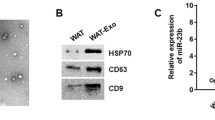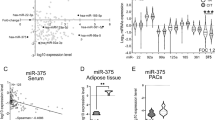Abstract
Targeting the white-to-brown fat conversion is important for developing potential strategies to counteract metabolic diseases; yet the mechanisms are not fully understood. Yes-associated-protein (YAP), a transcription co-activator, was demonstrated to regulate adipose tissue functions; however, its effects on browning of subcutaneous white adipose tissue (sWAT) are unclear. We demonstrated that YAP was highly expressed in cold-induced beige fat. Mechanistically, YAP was found as a target gene of miR-429, which downregulated YAP expression in vivo and in vitro. In addition, miR-429 level was decreased in cold-induced beige fat. Additionally, pharmacological inhibition of the interaction between YAP and transcriptional enhanced associate domains by verteporfin dampened the browning of sWAT. Although adipose tissue-specific YAP overexpression increased energy expenditure with increased basal uncoupling protein 1 expression, it had no additional effects on the browning of sWAT in young mice. However, we found age-related impairment of sWAT browning along with decreased YAP expression. Under these circumstances, YAP overexpression significantly improved the impaired WAT browning in middle-aged mice. In conclusion, YAP as a regulator of sWAT browning, was upregulated by lowering miR-429 level in cold-induced beige fat. Targeting the miR-429-YAP pathway could be exploited for therapeutic strategies for age-related impairment of sWAT browning.
Similar content being viewed by others
References
Arner, P., and Kulyté, A. (2015). MicroRNA regulatory networks in human adipose tissue and obesity. Nat Rev Endocrinol 11, 276–288.
Bracken, C.P., Li, X., Wright, J.A., Lawrence, D.M., Pillman, K.A., Salmanidis, M., Anderson, M.A., Dredge, B.K., Gregory, P.A., Tsykin, A., et al. (2014). Genome-wide identification of miR-200 targets reveals a regulatory network controlling cell invasion. EMBO J 33, 2040–2056.
Chang, C.C., Chen, C.Y., Chang, G.D., Chen, T.H., Chen, W.L., Wen, H.C., Huang, C.Y., and Chang, C.H. (2017). Hyperglycemia and advanced glycation end products (AGEs) suppress the differentiation of 3T3-L1 preadipocytes. Oncotarget 8, 55039–55050.
Chen, M., Wu, L., Tu, J., Zhao, Z., Fan, X., Mao, J., Weng, Q., Wu, X., Huang, L., Xu, M., et al. (2018a). miR-590–5p suppresses hepatocellular carcinoma chemoresistance by targeting YAP1 expression. EBioMedicine 35, 142–154.
Chen, R., Zhu, S., Fan, X.G., Wang, H., Lotze, M.T., Zehrd, H.J., Billiar, T. R., Kang, R., and Tang, D. (2018b). High mobility group protein B1 controls liver cancer initiation through Yes-associated protein -dependent aerobic glycolysis. Hepatology 67, 1823–1841.
Chen, Y., Siegel, F., Kipschull, S., Haas, B., Fröhlich, H., Meister, G., and Pfeifer, A. (2013). miR-155 regulates differentiation of brown and beige adipocytes via a bistable circuit. Nat Commun 4, 1769.
Chouchani, E.T., Kazak, L., and Spiegelman, B.M. (2019). New advances in adaptive thermogenesis: Ucp1 and beyond. Cell Metab 29, 27–37.
Crane, J.D., Palanivel, R., Mottillo, E.P., Bujak, A.L., Wang, H., Ford, R.J., Collins, A., Blümer, R.M., Fullerton, M.D., Yabut, J.M., et al. (2015). Inhibiting peripheral serotonin synthesis reduces obesity and metabolic dysfunction by promoting brown adipose tissue thermogenesis. Nat Med 21, 166–172.
Desjardins, E.M., and Steinberg, G.R. (2018). Emerging role of AMPK in brown and beige adipose tissue (BAT): Implications for obesity, insulin resistance, and type 2 diabetes. Curr Diab Rep 18, 80.
Duteil, D., Tosic, M., Willmann, D., Georgiadi, A., Kanouni, T., and Schüle, R. (2017). Lsd1 prevents age-programed loss of beige adipocytes. Proc Natl Acad Sci USA 114, 5265–5270.
Fu, L., Hu, Y., Song, M., Liu, Z., Zhang, W., Yu, F.X., Wu, J., Wang, S., Izpisua Belmonte, J.C., Chan, P., et al. (2019). Up-regulation of FOXD1 by YAP alleviates senescence and osteoarthritis. PLoS Biol 17, e3000201.
Furth, N., Aylon, Y., and Oren, M. (2018). P53 shades of Hippo. Cell Death Differ 25, 81–92.
Guerrant, W., Kota, S., Troutman, S., Mandati, V., Fallahi, M., Stemmer-Rachamimov, A., and Kissil, J.L. (2016). YAP mediates tumorigenesis in neurofibromatosis type 2 by promoting cell survival and proliferation through a COX-2-EGFR signaling axis. Cancer Res 76, 3507–3519.
Harms, M., and Seale, P. (2013). Brown and beige fat: Development, function and therapeutic potential. Nat Med 19, 1252–1263.
He, J., Bao, Q., Yan, M., Liang, J., Zhu, Y., Wang, C., and Ai, D. (2018). The role of Hippo/Yes-associated protein signalling in vascular remodelling associated with cardiovascular disease. Br J Pharmacol 175, 1354–1361.
Jin, H., Lian, N., Zhang, F., Bian, M., Chen, X., Zhang, C., Jia, Y., Lu, C., Hao, M., Yao, S., et al. (2017). Inhibition of YAP signaling contributes to senescence of hepatic stellate cells induced by tetramethylpyrazine. Eur J Pharm Sci 96, 323–333.
Johnson, R.L. (2019). Hippo signaling and epithelial cell plasticity in mammalian liver development, homeostasis, injury and disease. Sci China Life Sci 62, 1609–1616.
Kim, H.J., Cho, H., Alexander, R., Patterson, H.C., Gu, M., Lo, K.A., Xu, D., Goh, V.J., Nguyen, L.N., Chai, X., et al. (2014). MicroRNAs are required for the feature maintenance and differentiation of brown adipocytes. Diabetes 63, 4045–4056.
Lemecha, M., Morino, K., Imamura, T., Iwasaki, H., Ohashi, N., Ida, S., Sato, D., Sekine, O., Ugi, S., and Maegawa, H. (2018). miR-494–3p regulates mitochondrial biogenesis and thermogenesis through PGC1-α signalling in beige adipocytes. Sci Rep 8, 15096.
Liu, A.M., Poon, R.T.P., and Luk, J.M. (2010). MicroRNA-375 targets Hippo-signaling effector YAP in liver cancer and inhibits tumor properties. Biochem Biophys Res Commun 394, 623–627.
Liu, W., Ye, C., Cheng, Q., Zhang, X., Yao, L., Li, Q., Huang, J., Liu, Y., Zou, Z., Wang, H., et al. (2019). Macrophage raptor deficiency-induced lysosome dysfunction exacerbates nonalcoholic steatohepatitis. Cell Mol Gastroenterol Hepatol 7, 211–231.
Liu, X., Cervantes, C., and Liu, F. (2017). Common and distinct regulation of human and mouse brown and beige adipose tissues: A promising therapeutic target for obesity. Protein Cell 8, 446–454.
Liu, X., Magee, D., Wang, C., McMurphy, T., Slater, A., During, M., and Cao, L. (2014). Adipose tissue insulin receptor knockdown via a new primate-derived hybrid recombinant AAV serotype. Mol Ther Methods Clin Dev 1, 8.
Mori, M., Nakagami, H., Rodriguez-Araujo, G., Nimura, K., and Kaneda, Y. (2012). Essential role for miR-196a in brown adipogenesis of white fat progenitor cells. PLoS Biol 10, e1001314.
Papatheodoridi, A.M., Chrysavgis, L., Koutsilieris, M., and Chatzigeorgiou, A. (2020). The role of senescence in the development of nonalcoholic fatty liver disease and progression to nonalcoholic steatohepatitis. Hepatology 71, 363–374.
Park, S.M., Gaur, A.B., Lengyel, E., and Peter, M.E. (2008). The miR-200 family determines the epithelial phenotype of cancer cells by targeting the E-cadherin repressors ZEB1 and ZEB2. Genes Dev 22, 894–907.
Perra, A., Kowalik, M.A., Ghiso, E., Ledda-Columbano, G.M., Di Tommaso, L., Angioni, M.M., Raschioni, C., Testore, E., Roncalli, M., Giordano, S., et al. (2014). YAP activation is an early event and a potential therapeutic target in liver cancer development. J Hepatol 61, 1088–1096.
Ramos, A., and Camargo, F.D. (2012). The Hippo signaling pathway and stem cell biology. Trends Cell Biol 22, 339–346.
Rogers, N.H., Landa, A., Park, S., and Smith, R.G. (2012). Aging leads to a programmed loss of brown adipocytes in murine subcutaneous white adipose tissue. Aging Cell 11, 1074–1083.
Santinon, G., Brian, I., Pocaterra, A., Romani, P., Franzolin, E., Rampazzo, C., Bicciato, S., and Dupont, S. (2018). dNTP metabolism links mechanical cues and YAP/TAZ to cell growth and oncogene-induced senescence. EMBO J 37, e97780.
Scheja, L., and Heeren, J. (2016). Metabolic interplay between white, beige, brown adipocytes and the liver. J Hepatol 64, 1176–1186.
Tharp, K.M., Kang, M.S., Timblin, G.A., Dempersmier, J., Dempsey, G.E., Zushin, P.J.H., Benavides, J., Choi, C., Li, C.X., Jha, A.K., et al. (2018). Actomyosin-mediated tension orchestrates uncoupled respiration in adipose tissues. Cell Metab 27, 602–615.e4.
Totaro, A., Panciera, T., and Piccolo, S. (2018). YAP/TAZ upstream signals and downstream responses. Nat Cell Biol 20, 888–899.
Wang, L., Luo, J.Y., Li, B., Tian, X.Y., Chen, L.J., Huang, Y., Liu, J., Deng, D., Lau, C.W., Wan, S., et al. (2016). Integrin-YAP/TAZ-JNK cascade mediates atheroprotective effect of unidirectional shear flow. Nature 540, 579–582.
Wang, W., and Seale, P. (2016). Control of brown and beige fat development. Nat Rev Mol Cell Biol 17, 691–702.
Wang, X.W., Heegaard, N.H.H., and Orum, H. (2012). MicroRNAs in liver disease. Gastroenterology 142, 1431–1443.
Wu, J., Boström, P., Sparks, L.M., Ye, L., Choi, J.H., Giang, A.H., Khandekar, M., Virtanen, K.A., Nuutila, P., Schaart, G., et al. (2012). Beige adipocytes are a distinct type of thermogenic fat cell in mouse and human. Cell 150, 366–376.
Xie, Q., Chen, J., Feng, H., Peng, S., Adams, U., Bai, Y., Huang, L., Li, J., Huang, J., Meng, S., et al. (2013). YAP/TEAD-mediated transcription controls cellular senescence. Cancer Res 73, 3615–3624.
Xu, F., Ahmed, A.S.I., Kang, X., Hu, G., Liu, F., Zhang, W., and Zhou, J. (2015). MicroRNA-15b/16 attenuates vascular neointima formation by promoting the contractile phenotype of vascular smooth muscle through targeting YAP. Arterioscler Thromb Vasc Biol 35, 2145–2152.
Yamashita, H., Sato, Y., and Mori, N. (1999). Difference in induction of uncoupling protein genes in adipose tissues between young and old rats during cold exposure. FEBS Lett 458, 157–161.
Yang, X., Sui, W., Zhang, M., Dong, M., Lim, S., Seki, T., Guo, Z., Fischer, C., Lu, H., Zhang, C., et al. (2017). Switching harmful visceral fat to beneficial energy combustion improves metabolic dysfunctions. JCI Insight 2, e89044.
Yoneshiro, T., Aita, S., Matsushita, M., Okamatsu-Ogura, Y., Kameya, T., Kawai, Y., Miyagawa, M., Tsujisaki, M., and Saito, M. (2011). Age-related decrease in cold-activated brown adipose tissue and accumulation of body fat in healthy humans. Obesity 19, 1755–1760.
Yu, F.X., Zhao, B., and Guan, K.L. (2015). Hippo pathway in organ size control, tissue homeostasis, and cancer. Cell 163, 811–828.
Yu, F.X., Zhang, Y., Park, H.W., Jewell, J.L., Chen, Q., Deng, Y., Pan, D., Taylor, S.S., Lai, Z.C., and Guan, K.L. (2013). Protein kinase a activates the Hippo pathway to modulate cell proliferation and differentiation. Genes Dev 27, 1223–1232.
Zhou, Q., Li, L., Zhao, B., and Guan, K.L. (2015). The Hippo pathway in heart development, regeneration, and diseases. Circ Res 116, 1431–1447.
Acknowledgements
This work was supported by the National Key Research and Development Program of China (2019YFA0802502), the National Natural Science Foundation of China (81770836, 81822006, 81700506) and the Natural Science Foundation of Tianjin (19JCQNJC10100).
Author information
Authors and Affiliations
Corresponding authors
Additional information
Compliance and ethics
The author(s) declare that they have no conflict of interest. The animal study conformed with the principles outlined in the Helsinki Declaration of 1975 (as revised in 2008).
Supporting Information
Rights and permissions
About this article
Cite this article
Ye, C., Duan, J., Zhang, X. et al. Cold-induced Yes-associated-protein expression through miR-429 mediates the browning of white adipose tissue. Sci. China Life Sci. 64, 404–418 (2021). https://doi.org/10.1007/s11427-020-1779-2
Received:
Accepted:
Published:
Issue Date:
DOI: https://doi.org/10.1007/s11427-020-1779-2




